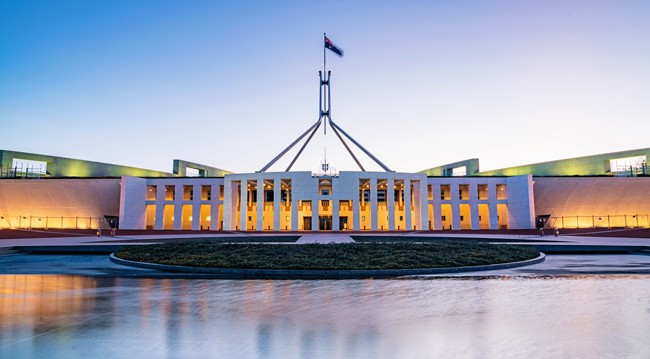Australia has set its 2035 emissions reduction target at 62–70 per cent below 2005 levels, accompanied by a net zero plan and more than $8bn in new measures to support the transition. The target sits within the range of advice from the Climate Change Authority and is being framed by the government as both ‘ambitious’ and ‘achievable’. The announcement was made in a week of major climate developments that also saw the release of Australia’s first National Climate Risk Assessment.
This newsletter will pause in October as the AICD updates its platforms. Please look out for updates via the AICD Member Briefing and our social media channels, and we look forward to resuming our regular monthly schedule in November.
Also in this newsletter:
- Environment Minister announces reforms to speed up environmental approvals.
- Parliament to refine mandatory climate reporting laws, clarifying modified liability protections.
- Deloitte shares lessons from the first mandatory climate reporting period, with insights for directors.
- Market developments: Consultation opens on Australia’s Strategy for Nature 2024–2030; national emissions fell 1.4 per cent in the year to March 2025.
Government announces 2035 emissions cut of 62–70 per cent from 2005 levels
The Albanese Government has set Australia’s 2035 emissions reduction target at 62–70 per cent below 2005 levels, following Cabinet deliberations and advice from the Climate Change Authority. The decision fulfils a Paris Agreement requirement to submit a new nationally determined contribution this month and comes ahead of the UN General Assembly meeting in New York this month and comes ahead of the UN General Assembly meeting in New York.
A net zero plan accompanies the target, outlining transition measures across six sectors: electricity and energy, transport and infrastructure, industry, built environment, agriculture and land, and resources. Treasury modelling, also released, indicates that an ‘orderly transition' is likely to deliver better economic outcomes than a delayed or disorderly path. At the press conference, Treasurer Jim Chalmers said the target was carefully calibrated and ‘investable', adding that he was confident business would 'lean in and help'.
The Government also announced over $8 billion in new measures to support the transition, including funding through the National Reconstruction Fund, the Clean Energy Finance Corporation, and incentives for cleaner fuels and manufacturing.
The target is presented as ambitious, considered and the 'highest possible' in Australia’s national circumstances. Commentators noted, however, that it may fall short of expectations for a 1.5°C-aligned pathway. Australia’s legislated commitments remain a 43 per cent cut by 2030 and net zero by 2050.
Opposition Leader Sussan Ley said the Coalition was united in its opposition to the target saying it fails on ‘cost and credibility’.
The target announcement capped a week of major climate and energy measures, including approval of the North West Shelf Project extension with conditions related to protection of the World Heritage-listed Murujuga rock art and a requirement to reach net zero by 2050 under the Safeguard Mechanism. Pacific Islands Forum leaders also endorsed Australia’s bid to co-host COP31 with Pacific nations, even as Türkiye pursues a rival bid.
National Climate Risk Assessment warns of ‘severe’ impacts by 2050
Australia’s National Climate Risk Assessment, released this week, finds no community will be immune from cascading and compounding risks, with coastal flooding, extreme heat and infrastructure disruption posing significant threats by mid-century. Under a 3-degree scenario, extreme heat deaths in Sydney could rise by more than 400 per cent, while three million people would face very high risk from coastal hazards across the country.
Northern Australia, outer suburban areas and remote communities are identified as especially vulnerable. Released alongside a National Adaption Plan, the assessment identifies 63 nationally significant climate risks, with 11 analysed in detail across eight functional systems – from health and infrastructure to the economy, environment and primary industries – and highlights four cross-system risks: coastal communities, governance, supply chains and water security. The assessment shows that under current policy settings, all systems will experience ‘very high’ or ‘severe’ effects from climate change by 2050.
Bill to extend Modified Liability Protections for sustainability reporting
As directors may be aware, a three-year ‘modified liability period’ applies to sustainability reports required under mandatory climate reporting laws, limiting enforcement of forward-looking disclosures to regulators only. This covers all forward-looking disclosures under the ASRS for the regime’s first year, and scope 3, scenario analysis and transition planning disclosures for the first three years. The protections also extend to subsequent statements made to comply with Commonwealth law, where those statements are the same as the protected disclosures (or contain only updates or corrections).
The Treasury Laws Amendment (Strengthening Financial Systems and Other Measures) Bill 2025, currently before Parliament, is expected to extend the modified liability regime in certain circumstances. This would include voluntary sustainability reports, provided they contain the content required under the Corporations Act 2001 (Cth) and include a director declaration that section 1707DA applies. The policy intention is to support entities that are early adopters or reporting voluntarily.
The Bill does not clarify how the regime applies to other corporate disclosures that reference or summarise climate reporting outside of sustainability reports. Directors should assume that such statements remain subject to the usual director liability considerations.
Mandatory climate reporting: Navigating governance risks in Australia’s first wave
With few international precedents to draw on, the world is watching how Australia navigates its first wave of mandatory ISSB-aligned climate disclosures. Deloitte’s Jonathan Streng – a lead author of A director’s guide to mandatory climate reporting – has seen early examples that highlight issues directors must keep front of mind. These include unsubstantiated future promises, labelling confusion, and misunderstandings around limited liability protection.
The ISSB highlights two key principles – connectivity and proportionality – reminding boards that proportionality relief on information-gathering does not equate to exemption from disclosure. Companies must still provide the required disclosures using the best available information. Anticipated financial effects will often be estimated, scenario-based and uncertain, but what matters is transparency in assumptions and methods, not unattainable precision.
Market developments update
- Woodside accepts tougher conditions for North West Shelf extension
The AFR reports, Woodside has revised its plans for the North West Shelf extension, agreeing to 48 federal conditions that aim to limit industrial emissions and protect sacred Murujuga rock art, after the project won environmental approval to run until 2070. - Reforms to speed up federal environmental approvals
Environment Minister Murray Watt has confirmed reforms to the EPBC Act will introduce regional planning, with ‘go’ and ‘no-go’ zones to streamline project approvals. The government has committed to introducing the legislation before the end of 2025. - Australia opens consultation on Strategy for Nature implementation plan
The government has released the Australia’s Strategy for Nature 2024–2030, setting national targets to halt and reverse biodiversity loss, protect and repair ecosystems, and tackle its drivers. Consultation is now open on the implementation plan, seeking input from governments, communities, businesses and individuals until 15 October 2025. - Overall Australian emissions fall, but transport rises
Australia’s emissions fell 1.4 per cent in the year to March 2025, reaching 440.2 Mt CO₂-e – 28.1 per cent below 2005 levels. While reductions were recorded across electricity, agriculture and industry, transport emissions rose, driven by higher diesel use and domestic aviation. - State of the energy market report 2025 released
The Australian Energy Regulator’s 2025 report highlights record growth in renewables, with battery storage, solar and wind additions lifting renewables to 60 per cent of National Electricity Market (NEM) capacity in 2024. Despite this progress, challenges remain, including coal retirements, infrastructure delays and integrating consumer energy resources. - Reliability outlook for the NEM improves
Australian Energy Market Operator (AEMO) forecasts electricity demand will rise 28 per cent by 2035 (from 178 terawatt hours (TWh) to 229 TWh), led by data centres and business electrification. It says demand can be met if new generation, storage and transmission projects – including those backed by the Capacity Investment Scheme – are delivered on time.
Research and guidance
- Infrastructure Australia releases report on Australia’s net zero workforce
The IA report warns the net zero infrastructure workforce, now 130,000 strong across 36 occupations, must rapidly expand and upskill, saying to meet demand by 2050 will require major investment in training and workforce planning. - New disclosure guides for the Australian energy sector
A collaboration between industry and regulators has produced two new disclosure guides to help energy companies report climate risks and align with international standards. The first, an Emissions Reporting Guide for consistent scope 3 reporting in electricity, and the second, an AASB S2 Scenario Analysis Guide to help companies assess climate risks and opportunities. - Global carbon storage capacity is limited
Research in the scientific journal Nature suggests geological carbon storage capacity could be exhausted by 2200 at current rates. The authors call for carbon capture to be treated as a finite resource, reinforcing the urgency of emissions reduction at source. - Sequestration potential of reforestation overestimated
Meanwhile, a study in science journal Science finds 389m hectares are suitable for reforestation – half of previous estimates. The authors argue reforestation cannot substitute for deeper emissions cuts.
Global developments
- EU countries delay deal on new climate goal
Reuters reports that EU member states have failed to agree on a new bloc-wide climate goal, pushing negotiations into later this year. - US EPA proposes end to mandatory greenhouse gas reporting
Reuters also reports the US Environmental Protection Agency has proposed ending mandatory greenhouse gas reporting for around 8000 facilities, a move likely to spark significant debate among policymakers and industry. - Singapore delays climate reporting requirements
Singapore has delayed mandatory climate reporting to give smaller companies more time to prepare, extending the phase-in period for SMEs. All listed firms must still report scope 1 and 2 emissions from FY2025, with the largest to add scope 3 from FY2026. - Swiss Re drops pursuit of SBTi validation, retains goals
Swiss Re will no longer seek Science Based Targets initiative (SBTi) validation for its net zero goals, citing the need for flexibility in its climate strategy. - California issues climate disclosure guidance
The California Air Resources Board has released guidance to help companies comply with the state’s new climate disclosure laws, due to take effect from 2026. - Energy transition plans lack detail
E3G’s NDC Energy Commitments Tracker finds that while 94 per cent of countries are planning some contribution to global energy transition goals, none yet have a comprehensive plan. In 2025, all countries party to the Paris Agreement, including Australia, are due to submit updated or new Nationally Determined Contributions (NDCs) through 2035. - Joint call for business action on nature
IUCN, TNFD and the Nature Positive Initiative have issued a joint statement urging bold, science-based and collaborative action to halt and reverse nature loss. The groups will convene over 50 business leaders at a high-level Business Summit during the IUCN World Conservation Congress in Abu Dhabi this October, spotlighting credible leadership, partnerships and investment opportunities to advance a nature-positive economy.
AICD climate governance courses
- Climate Governance for Australian Directors (Online Short Course): An interactive four-week course designed to build director capability on climate governance, climate reporting and board oversight of transition planning.
- Introduction to Climate Governance (Online Module): Available anytime, free for members. A self-paced module providing an overview of directors’ duties, climate risks and opportunities.
Already a member?
Login to view this content




